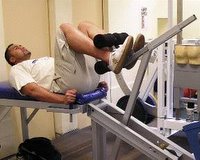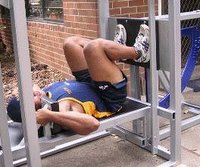MyoQuip is fortunate to have access to a comprehensive gym facility for testing the prototypes of its various machines. Early in 2004 the first version of the ScrumTruk was installed at Sydney University's Arena Gymnasium. Since then successive prototypes and models have been tested there.
Sydney University Sport currently has 250 athletes on scholarship across a wide range of sports. Their strength training is supervised by Martin Harland, a highly-regarded sports scientist who has worked with a number of Australian professional sporting teams. Martin also has direct responsibility for the University Rugby Club's EDS program.
Currently there are 70 players in the Elite Development Squad. Apart from their rugby they do intensive weight training for eleven months of the year. For the past two playing seasons the ScrumTruk has been an integral part of their programs. The 2005 season was the most successful in the Club's 142-year history. Premierships were won by five of its eight teams, including First Grade, Second Grade and First Colts. Across the grades the Club's players consistently drew comment for their size and physicality and ability to dominate at the scrum and maul.
During the current off-season the EDS players are continuing to use the ScrumTruk but are also working with prototypes of three new machines that will be released in the near future. These are the JumpTruk (for improving lineout lifting); the HipneeFlex (for developing hip and knee flexors); and the HipneeThrust (a supine leg press with plyometric characteristics). All three machines utilise QuadTorq technology.


rugby
Sydney University
ScrumTruk
Friday, December 30, 2005
Testing MyoQuip prototypes at Sydney University
Labels:
Martin Harland,
rugby,
ScrumTruk,
Sydney University
Subscribe to:
Post Comments (Atom)










5 comments:
Specilist training for specialist movement. The machine looks good. How else do you get that horizontal position. See how it hits the calves. I found my calves straining big time in Rugby..
How about something that specialises in Strengthening the Neck. There simply are no machine that do this, well not in standard gyms. You need to strengthen the players to be able to hit with the head accross the front of the opponents body
Your observation about "hitting the calves" is spot on, Philip. The ScrumTruk gives very good plantar flexion, something that you obviously don't get with the barbell squat, for example. The posterior muscles of the calf, principally the gastrocnemius and soleus, are potentially very powerful but frequently are underdeveloped. Superior strength here can be very useful in scrummaging.
I am intrigued by your statement with regard to the neck, namely: "You need to strengthen the players to be able to hit with the head across the front of the opponent's body." Unless I misunderstand you, I suggest that many people in rugby, myself included, woudn't want to go there. Deliberately hitting with an unprotected head seems a potentially perilous action, and apart from any other considerations,any coach advocating it would need to be aware of the legal implications that could arise.
Could you comment further?
In American Football the contact in run blocking and tackling technique is to make contact with the head and front of the shoulder/upper chest area simultaneously, however in the American game you face and head are protected by a helmet and face cage and the helmet and pads provide some bracing on impact so long as the head is up. However I think what Philip is alluding to is when you make a tackle from the side or front three quarters (e.g. cover defence covering the corner flag or fly-half tackling the centre) the classical rugby technique is to tackle with the head behind the player, but this inevitably allows the ball carrier to fall forward which could result in a try or the ball carrier breaking what in American football is called an arm tackle. What Philip seems to be suggesting is that if one were to cross the ball carrier with your head and shoulders aiming at the far side of the player (presumably where he is holding the ball)you can change the net leverage effect of the tackle allowing the tackler to get in underneath the ball carrier to drive up and through and thus stop the forward momentum of the ball carrier. This would require a fairly strong, chest, traps and neck as the head would have to be kept up, because as in football injury would be inevitable if the neck were not kept in at least the spine neutral position.
However going back to neck strength required by scrum tight forwards especially the front row on the hit (or just after). Is there not a requirement to try and lift the opponent slightly to get a better leverage position? Using the neck would be vital - This goes back to my school boy days (rule changes may have affected this) in at hooker when we drove on the opponents put-in I remember if I could get some upward leverage on the opposite hookers chest we could disrupt their scrum as they hooked the ball as our front row would then typically be able to drive them back. Is there a place for the addition of a neck training device as an add on to one of your other machines?
I see what you mean, Nick. I think that I misunderstood Philip, for which I apologise. I read his comment as "hit with the head" which alarmed me, but what I think you are suggesting he means is that when the player hits the opponent, his head is "across the front of the opponent's body." In the circumstances you describe it could be justifiable and potentially very effective, but it obviously requires a high degree of skill and, as Philip suggests, neck strengthening for reasons of safety.
With regard to your question: "Is there a place for the addition of a neck training device as an add on to one of your other machines?", we actually have a partly-assembled prototype of a machine designed specifically to develop the ability of frontrowers to exert upward leverage when in the scrummaging position. As such it would primarily involve the erector spinae. In my view an increased ability to exert and maintain upward leverage is valuable in overcoming the tendency for front rows to go to ground.
You also allude to the potential for the hooker to disrupt the opposition front row. This is an area that receives little attention when the performance of frontrowers is discussed. Because the hooker is effectively hidden in the scrum, if he is sufficiently strong and guileful he is able to work over the opposition hooker or tighthead with virtual impunity, unnoticed by the referee. He is also in the optimal position mechanically to contribute to the forward momentum of his pack.
Very interesting reading. Thanks.
Sincerely,
Pat
ringgold
Post a Comment